|
|
Post by 1dave on Nov 4, 2018 19:37:41 GMT -5
Agate is sedimentary in nature but often forms in various volcanic rocks. As these rocks are often metal rich, this can produce desirable colors and patterns. 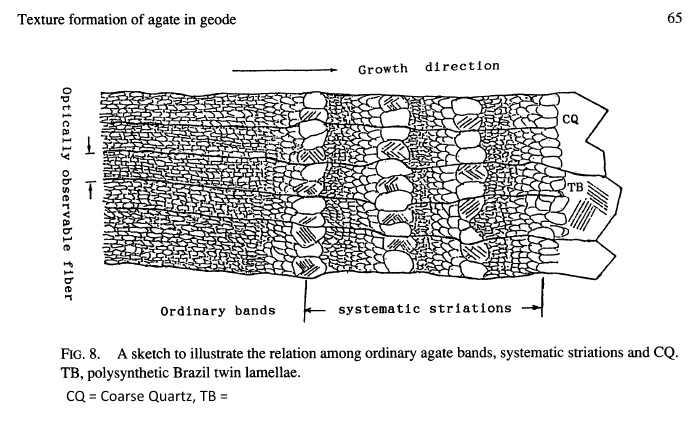 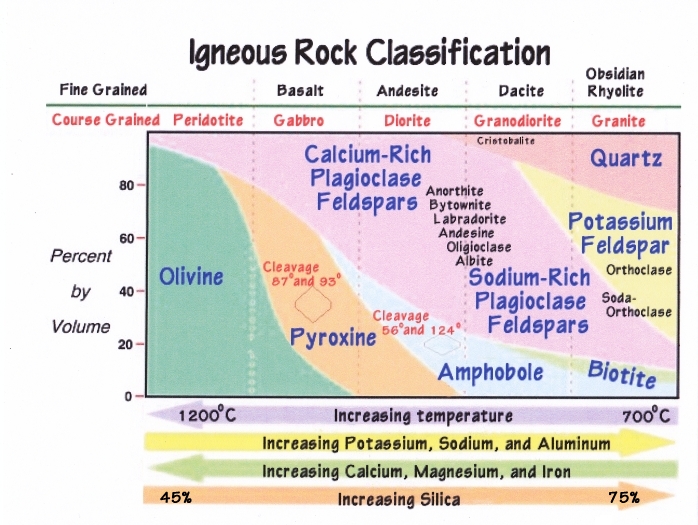 1. Gas Bubbles in Basalt and Andesite, (amygdaloids - "almond shaped" tear-drops, etc.) 1. Gas Bubbles in Basalt and Andesite, (amygdaloids - "almond shaped" tear-drops, etc.) commonly fill with agate and are known as Geodes (earth shaped). A careful search may reveal the paths where fluid entered and exited.  Formed in Basalt - has a smooth top exterior.  Formed in Andesite - because of high temperature crystal growth has a rough exterior. 2. Spheroids in Rhyolite and Obsidian usually contain trapped high pressure water. As the lava cools and pressure is decreased, the waster is finally allowed to slowly expand into steam "blowing" internal openings that convert the spheroids into thophysae "blown rocks."The open spaces can fill with agate and are commonly known as Thundereggs.  Priday Plume - Richardson Ranch, Madras Oregon. 3. Rhyolite Clinkers can be surrounded by agate forming spectacular patterns.  Lavic 4. Highly siliceous Ash Flow Tuff racing along at 300-400 mph can produce amazing Moss, Plume, and Flame patterns.  5. Metamorphic volcanic rocks 5. Metamorphic volcanic rocks such as rhyolite can also provide desirable colors and pasterns. 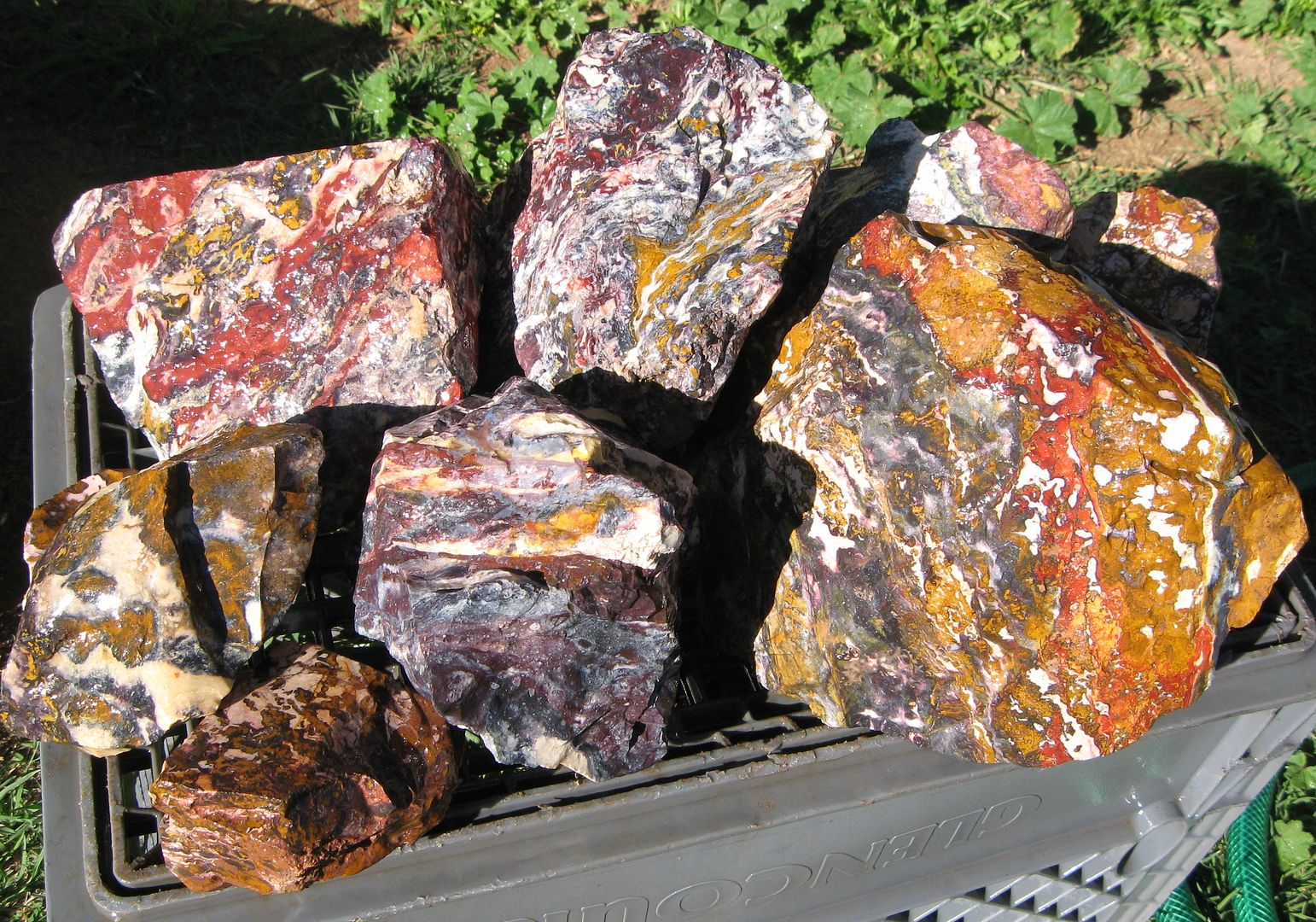 Indian Blanket - posted by beefjello [/quote] |
|
|
|
Post by 1dave on Nov 4, 2018 19:38:00 GMT -5
1. Gas Bubbles (Amygdaloids) in Basalt and Andesite Billions of years ago earth's basalt reached the surface at 3,000 oC. Today it is seldom above 1,200 0C, but is still very fluid and can flow for hundreds of miles before cooling. When a flow covers moist ground, the water turns to steam and fills the basalt with gas bubbles. As the basalt cools and contracts, billions of fractures are created, allowing rainwater to dissolve alkalies and silica that fill the voids. changes in minerals and temperature determine whether the voids are filled with chalcedony, moganite, twisting agate fibers ignoring gravity until lower temperatures allow gravity to take over and produce flat layers. Basalt generally has a composition of 45–55 wt% SiO2, 2–6 wt% total alkalis, 0.5–2.0 wt% TiO2, 5–14 wt% FeO and 14 wt% or more Al2O3. Contents of CaO are commonly near 10 wt%, those of MgO commonly in the range 5 to 12 wt%. Over time the voids fill with mineralised water that depending on temperature and ph collect on sides and at cooler temperatures in planes on the bottom. Sometimes a new eruption will re-heat the fluids and Fortification agate will form again on top of the waterline agate. 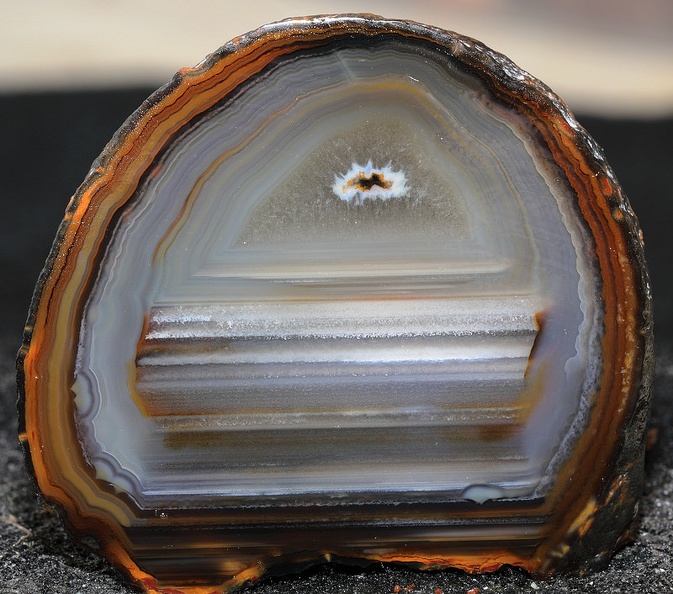  Brazilian geodes still in the matrix. 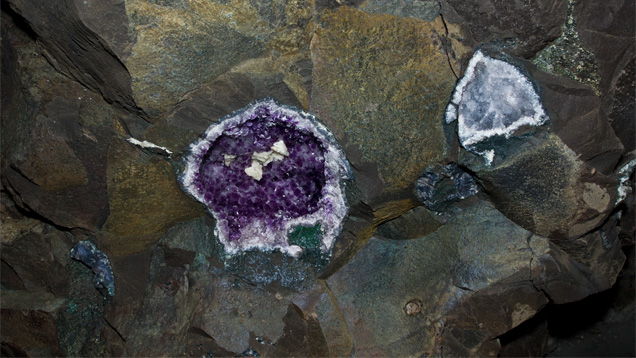 Basalt tends to be fine grained, so gas bubbles in it have fairly smooth surfaces. As the heavy minerals drop out of solution more feldspar and other lightweight crystals form so bubbles in Andesite have more rugged surfaces. 
|
|
|
|
Post by 1dave on Nov 4, 2018 19:38:14 GMT -5
2. Spheroids (Lithophasae) in Rhyolite and ObsidianThe mineral content of magma is constantly changing as iron and magnesium combine to form olivine crystals; calcium, sodium, and potassium form feldspars and they drop out of solution, making it more and more silica laden over time. Basalt ~ 45% Silica, Andesite ~ 55% Silica, Rhyolite ~ 65% Silica
BUT the Thunderegg Shells reach over 70% Silica! - - - - - - - - - - - - - - - - - - - - 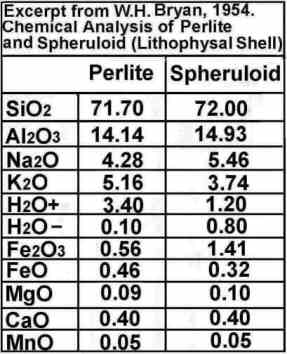 At 1,100 oC crystobalite needles form, making "puffballs" with very hot water trapped between the needles. The needles push out the calcium, sodium, and potassium molecules. All that movement causes friction and makes the magma hotter. It becomes too hot for crystobalite to form, but just right for Perthite feldspar to form a sphere around the puffball. The magma cools and crystobalite needles resume. You see them all the time as "Snowflake Obsidian." 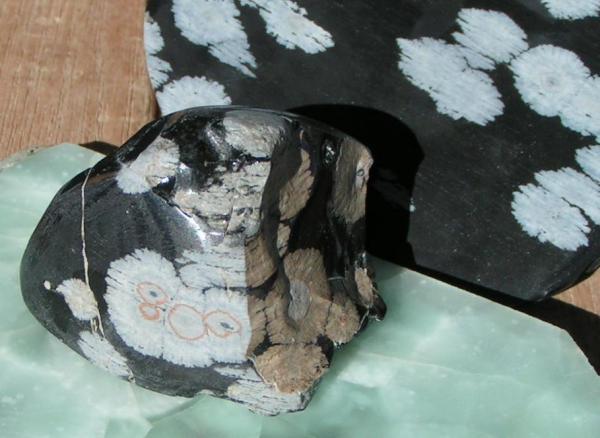 A Thunderegg Siamese Twin that formed in obsidian. 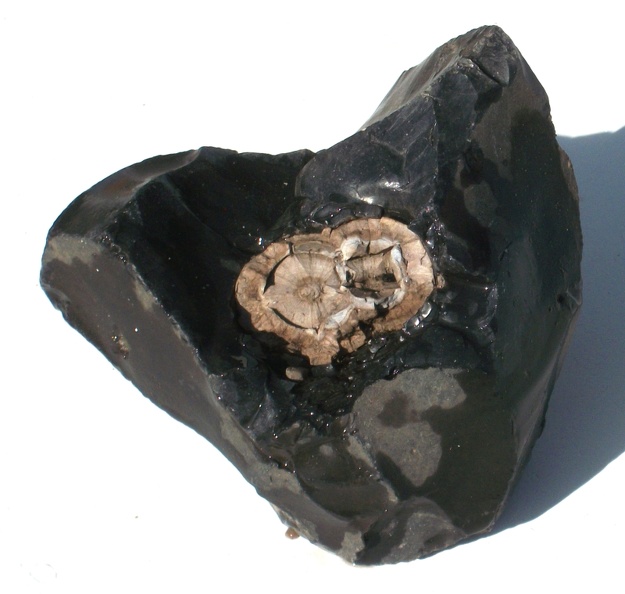 As the flow slowly cools and contracts, pressure is released and the water is finally allowed to expand into steam, forcing the needles apart.  As the gas forces the matrix apart around the thunderegg, "sutures" are formed where the sections break apart. If the gas escapes the sutures are sucked in. 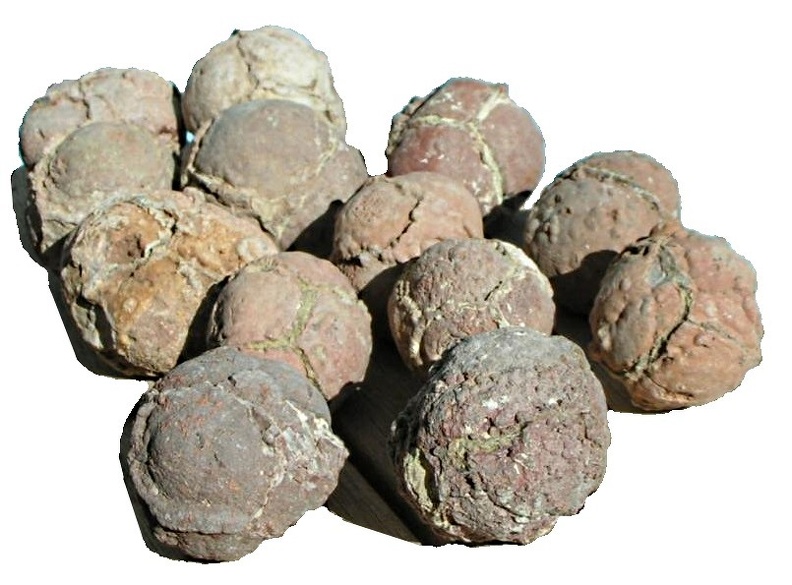 Later the Spheroid voids are filled with agate the same way as they are in basalt voids.
Finally the temperature becomes so cool crystobalite needles can no longer exist and they revert to other SiO2 forms, but they sometimes leave imprints to prove they once existed. Thunderegg Cores - the outer shells removed. 
|
|
|
|
Post by 1dave on Nov 4, 2018 19:39:03 GMT -5
3. Rhyolite ClinkersRhyolite is so thick as a liquid that instead of flowing, it often domes up as it did in Mt. St. Helen.   But sometimes repeated eruptions flow and form layers.  outsidetheinterzone.blogspot.com/2014/03/geo-730-march-12-day-436-lithophysal.html outsidetheinterzone.blogspot.com/2014/03/geo-730-march-12-day-436-lithophysal.html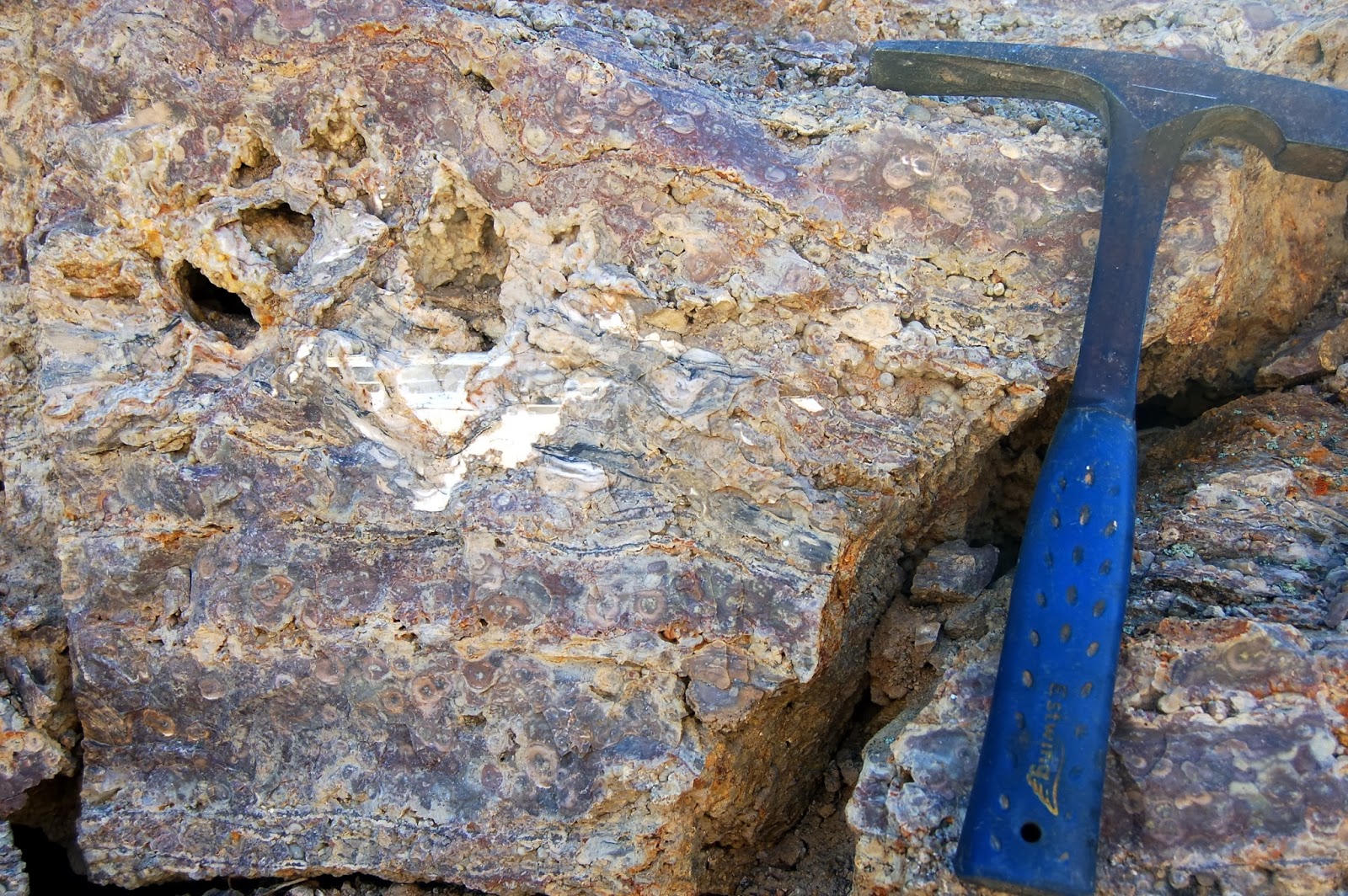 As lava flows, the top tends to move forward while the bottom sticks to the ground. This is known as "Caterpillar Action." 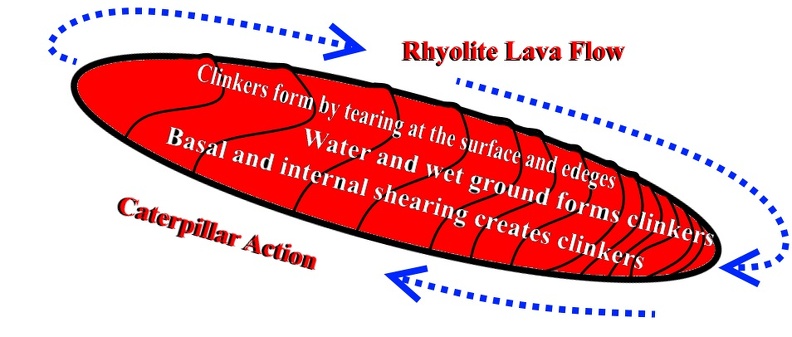 "Clinkers" "Clinkers" are lava fragments formed by fragmentation of a cooling crust because of an increase in viscosity and in shear strain rate. Surface clinkers are transported to the flow front by caterpillar motion, piled at the flow base, then buried as the flow covers them. Clinkers are fragmented in three different ways. 1. Surface Clinkers can form by cooling contraction and eventually become roll-over basal breccia by caterpillar action. 2. Internal Clinkers can form from brittle brecciation by internal and basal shear forces. 3. Basal Clinkers can form from Water/lava interactions. Water/lava ratio variations may produce different clinker structures, in a manner similar to observed textural changes in phreatomagmatic eruptions. A transition from clinkery particles to angular blocky particles is interpreted as an increase in groundwater inflow. When those spaces are filled with agate, it is time for the RTH Rock Rescue Teams to be called in!  rockgemmineralclubs.blogspot.com/2010/05/afms-field-trip-lavic-siding.html rockgemmineralclubs.blogspot.com/2010/05/afms-field-trip-lavic-siding.html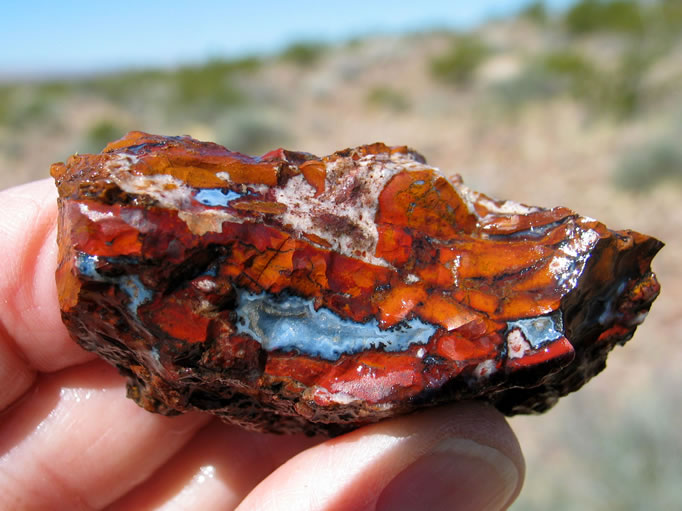
|
|
|
|
Post by 1dave on Nov 4, 2018 19:39:19 GMT -5
4. Highly Siliceous Ash Flow TuffMaterial expelled in volcanic eruptions can be classified as:
1. Volcanic gases, a mixture made mostly of steam, carbon dioxide, and a sulfur compound - either sulfur dioxide, SO2, or hydrogen sulfide, H2S, depending on the temperature. 2. Lava, the name of magma when it emerges and flows over the surface. 3. Tephra, (Tuff) chunks of solid material of all shapes and sizes ejected and thrown through the air. Chunks smaller than 2 mm in diameter (sand-sized or smaller) are called volcanic ash. Adding water to Rhyolite filled volcanoes can become explosive!  Here we are covering THREE separate subjects: 1. Ash FALL flat layers 2. Ash FLOW sloped layers 3. Welded Ash Flow layers  As ash fall flat layers rate -10 on a blah scale from 1 down to -10, - - - let's look at Ash FLOW sloped layers. They are Volcanic Land Slide Debris that traveled at various degrees of hotnesss, gassiness, and wetness. They consist of whatever was accumulated on the side of the volcano from all previous eruptions. There are 6 Types depending on depth and age of magmas and what has collected on volcanic hillsides: 1. Welded tuff, 2. Rhyolitic tuff, 3. Trachyte tuff, 4. Andesitic tuff, 5. Basaltic tuff, 6. Ultramafic tuff Lava, pumice, basalt, andesite, obsidian, rhyolite, agate, wind blown sand that suddenly moved away from a volcano at 100 km/h (62 mph) on average but is capable of reaching speeds up to 700 km/h (430 mph).[2] The gases can reach temperatures of about 1,000 °C (1,830 °F). The word pyroclast is derived from the Greek πῦρ, meaning "fire", and κλαστός, meaning "broken in pieces".[3] A name for pyroclastic flows which glow red in the dark is nuée ardente (French, "burning cloud"); this was first used to describe the disastrous 1902 eruption of Mount Pelée on Martinique where over 30,000 people were killed. Ash Flow Tuff may be fine or course grained mixtures sometimes resembling conglomerates. 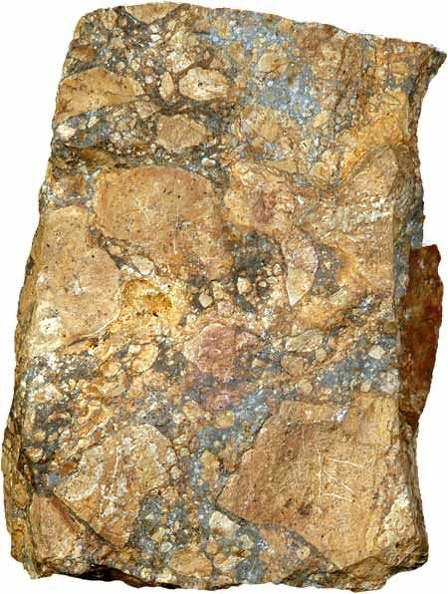 But, as at Holt Canyon in southwestern Utah, they can be far more interesting.  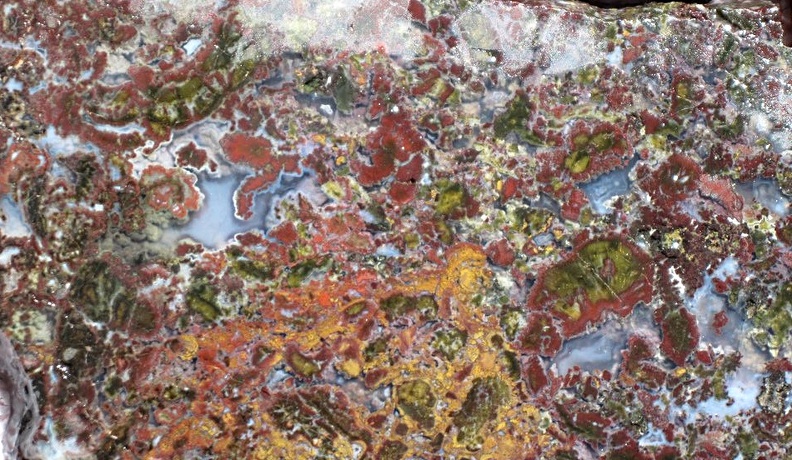  Ash FLOW slopes can appear in an instant over a large area, and hundreds of feet thick. Then something interesting begins to happen inside of them. Hot gas is expelled from the surface, glass shards begin to de vitrify, heat builds up in the core, pressure collapses space between shards, and glass shards begin to weld together. This is reversed at the base where the cool ground underneath stops the process. 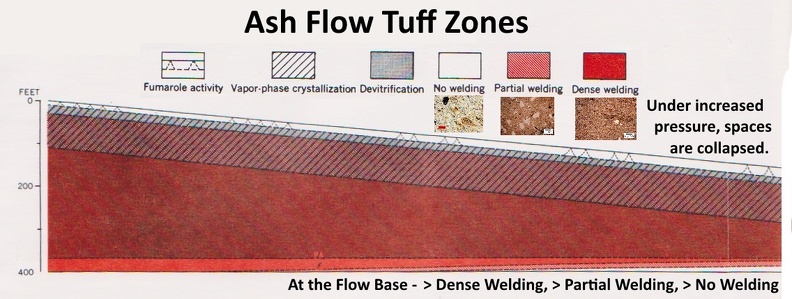  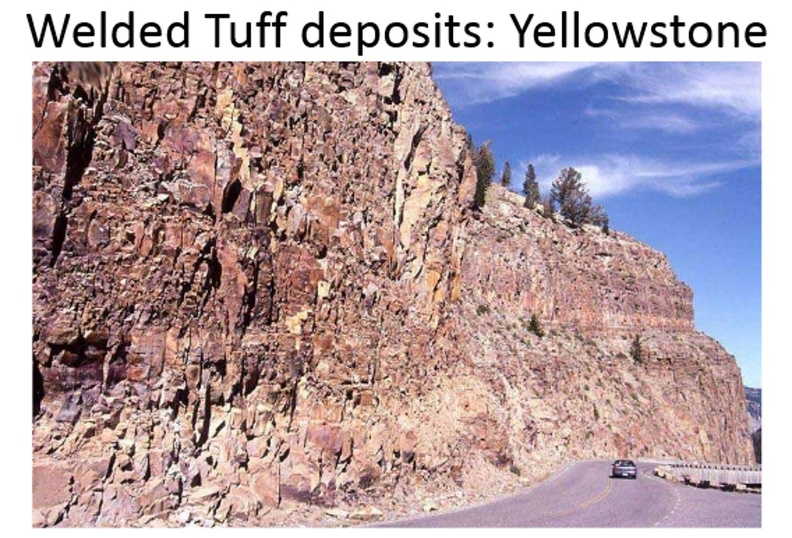 en.wikipedia.org/wiki/Pyroclastic_flowen.wikipedia.org/wiki/Tuff en.wikipedia.org/wiki/Pyroclastic_flowen.wikipedia.org/wiki/Tuff
|
|
|
|
Post by 1dave on Nov 4, 2018 19:39:42 GMT -5
5
|
|
|
|
Post by fernwood on Nov 5, 2018 7:47:21 GMT -5
Great info. What are the number posts for? Only see the numbers, nothing else.
|
|
|
|
Post by 1dave on Nov 5, 2018 9:43:22 GMT -5
Great info. What are the number posts for? Only see the numbers, nothing else. I'm getting slower all the time. I just edited #1. No idea if I'll get to the rest of them today or not. |
|
|
|
Post by fernwood on Nov 5, 2018 9:53:27 GMT -5
This is an excellent contribution. I had no idea some of these were of a volcanic heritage. Had to grab some of my halved and sliced geodes/thunder eggs and look at them. Yes, I can see where the liquid came in for some.
You have been such a blessing to me in my knowledge quest. Appreciate you very much.
|
|
|
|
Post by fernwood on Nov 5, 2018 9:54:13 GMT -5
PS, love the water line slice.
|
|
Fossilman
Cave Dweller 
Member since January 2009
Posts: 20,722 
|
Post by Fossilman on Nov 6, 2018 10:47:48 GMT -5
Excellent information.......
|
|
|
|
Post by pauls on Nov 6, 2018 15:11:28 GMT -5
Thanks Dave The Agate Creek Queensland Agate originates in Basalt/Andesite, its fairly easy to pick up hand specimens of "Basalt" full of small vesicles filled with Agate, sawed in half they are quite atractive. A lot of the sites for good Agate require digging in the weathered Basalt. Once you hit the unweatherd Basalt the Agates win. (unless its a nice big one worth skinning your knuckles for.) I'm not sure if this has been posted before but this fellow has some interesting Agate information. depositsmag.com/2018/03/27/agate-a-mineral-that-develops-with-age-water-and-moganite/ |
|
|
|
Post by rockjunquie on Nov 6, 2018 15:16:30 GMT -5
Well done.... again! I hope you finish the thread. Looking forward to it. You've done a good job of visually explaining the processes.
|
|
saxplayer
fully equipped rock polisher
  
Member since March 2018
Posts: 1,327
|
Post by saxplayer on Nov 6, 2018 15:54:33 GMT -5
Thanks Dave The Agate Creek Queensland Agate originates in Basalt/Andesite, its fairly easy to pick up hand specimens of "Basalt" full of small vesicles filled with Agate, sawed in half they are quite atractive. A lot of the sites for good Agate require digging in the weathered Basalt. Once you hit the unweatherd Basalt the Agates win. (unless its a nice big one worth skinning your knuckles for.) I'm not sure if this has been posted before but this fellow has some interesting Agate information. depositsmag.com/2018/03/27/agate-a-mineral-that-develops-with-age-water-and-moganite/Hey Paul, paulsI almost have all your Queensland agates you sent me done tumbling  Can't wait to show them.. they are fantastic. Grant |
|
|
|
Post by 1dave on Nov 8, 2018 20:17:46 GMT -5
As usual I got side tracked - this time by Cove Mountain in north central Washington Co., Utah. Southwest of there is where I have collected some of my most treasured agates. Called "Pipeline Canyon Agate" and "Holt Canyon Agate," perhaps a more accurate name is - "West of Cove Hollow Agate."
HOW DID IT GET THERE? That is quite a story!  What am I referring to? Rocks like these.   Notice something odd about that surface? a closer look.  SiO 2 does not take that form, but pyrite does. That surface was the top of an ASH FLOW TUFF!  Tommy Tommy remember digging under that bush?  Again, how did it get there? as brief as I can, it started 22-23 million years ago during the Laramide orogeny. As North America moved west and the Pacific seafloor worked its way east beneath the continent, one of a series of volcanoes began erupting and building a cone in the Bull Valley west of Pine Valley. Then there was a collapse of the east wall of the volcano around 22-23 million years ago, creating the Rencher Ash Flow Tuff that flowed toward the Pine Valley area. Next the Pine Valley syncline started as a Laramide downwarp which was further depressed during the intrusion of the 3,000 foot tall mushroom shaped Pine Valley laccolith - The largest laccolith in the U.S., and possibly in the world!.That caused a Gravity Slide Breccia to the west and south of Cove mountain. The growing laccolith bathed the are with hot water for millions of years! Minerals were dissolved and others precipitated and our agate was born. |
|
|
|
Post by 1dave on Nov 9, 2018 15:01:19 GMT -5
Where to look? Similar material can be found all across the Rhyolitic Volcanic West from Washington, Oregon, California - to Texas.  In my area look for the white area with red cross-hatching marked Tgb (Tertiary gravity slide breccia). 1. South part of Iron County
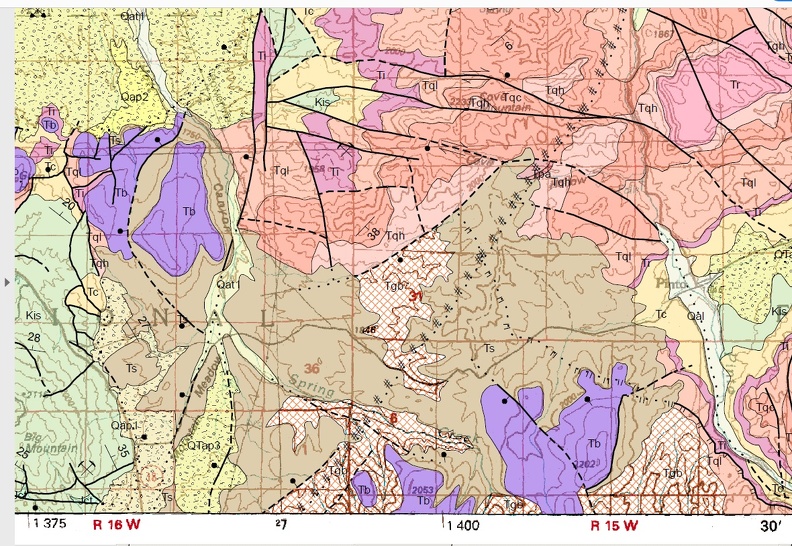 In the following map, south of the area above, Tgb (Tertiary gravity slide breccia) is stippled pink.
2. North part of Washington County.  |
|
RWA3006
Cave Dweller 
Member since March 2009
Posts: 4,625 
|
Post by RWA3006 on Nov 9, 2018 21:08:49 GMT -5
Interesting! I have a pal, an old timer who has a number of the thunder egg cores like the center one in the bottom most photo of #2. He got them from Dugway and as we were looking them over we noticed that each one has a male and female dimple on opposite sides. You can see the male dimple on the top of yours in your photo. My bud theorizes that the opposite dimples are a result from polarity forces during formation. I have no clue. What do you think?
|
|
|
|
Post by 1dave on Nov 9, 2018 22:33:29 GMT -5
Interesting! I have a pal, an old timer who has a number of the thunder egg cores like the center one in the bottom most photo of #2. He got them from Dugway and as we were looking them over we noticed that each one has a male and female dimple on opposite sides. You can see the male dimple on the top of yours in your photo. My bud theorizes that the opposite dimples are a result from polarity forces during formation. I have no clue. What do you think? The "dimple and pimple" is formed at the layer where the most water flashed into steam and pushed the egg open. Sometimes it is on a small sphere layer, sometimes large, and once in a while many layers opened at the same time. 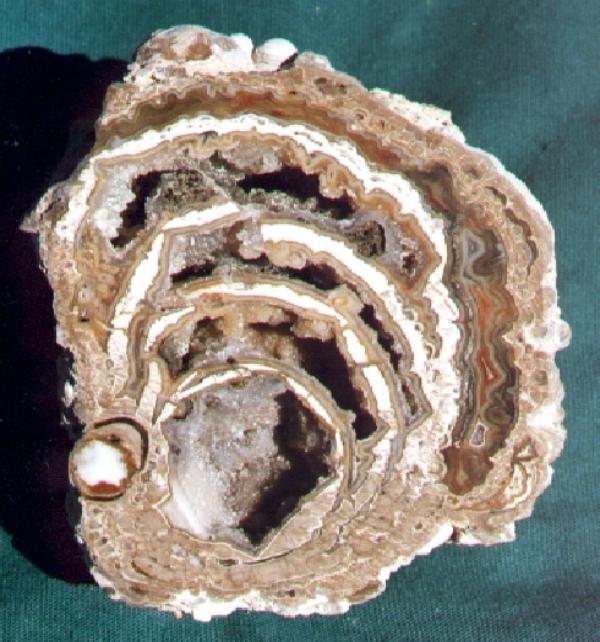 |
|
|
|
Post by 1dave on Nov 10, 2018 13:36:53 GMT -5
The Iron Axis laccolith swarm consists of a series of early Miocene calc alkaline hypabyssal laccoliths and associated volcanic rocks (Figures 1a and 1b). The intrusions occur as isolated bodies, but spatially coincide with a major fault zone at depth [Mackin, 1960; Blank and Mackin, 1967; Blank et al., 1992; Rowley et al., 1995; Rowley, 1998]. The intrusions are distributed along a northeast trending zone that follows the trend of the Sevier orogenic front (Figures 1b and 1c). More than a dozen exposed intrusions have been mapped in the magmatic province and others are inferred from structures in the cover rock and aeromagnetic signatures or are known from drilling and seismic data. During the emplacement of the Iron Axis intrusions, the area lacked any tectonic activity (i.e., regional strain) facilitating forcible emplacement into Mesozoic sedimentary rocks driven only by magmatic pressure at depths ranging mostly between 2.5 and 0.25 km from the surface [Hacker, 1998; Hacker et al., 2002]. Several of the intrusions deformed their roofs by upward folding and faulting, typical of the classic style of laccolithic emplacement [Gilbert, 1877; Corry, 1988; Jackson and Pollard, 1988]. The Pine Valley, Bull Valley Big Mountain, Pinto Peak, Stoddard Mountain, and Iron Mountain intrusions were partially unroofed by catastrophic gravity sliding, leading to explosive eruptions forming ash flow tuffs and lava flows that buried the gravity slide masses [Mackin, 1960; Hacker, 1998].
Conclusions
[30] The Pinto Peak intrusion provides insight into the evolution of a relatively small intrusive—extrusive volcanic system. The system is highly unusual in that the country rocks show no deformation associated with the emplacement of magma to shallow depths that led to a gravity slide off the roof of the intrusion leading to an explosive eruption. Rock magnetic and remanence studies indicate that the AMS fabrics are carried by multidomain titanomagnetite grains that vary in composition spatially across the intrusion. The intrusion is a porphyritic andesite and the silicate and oxide minerals do not typically show planar or linear fabrics in the field or in thin section. The results from the AMS study map out a sequence of events from steep magma ascent from depth to a shallow crustal level as defined by magmatic fabrics in the southern part of the intrusion. Following eruption triggered by the gravity slide, the magma drained away from the vent area with subhorizontal magma flow as defined by the magnetic fabrics located in the northern part of the intrusion. The deceptively simple outcrop pattern of the Pinto Peak intrusion hides a more complex magma flow and emplacement history as evidenced by the results of this study.
|
|
|
|
Post by 1dave on Nov 19, 2020 22:53:58 GMT -5
I've become a forgetful old man! This is another thread I started and never got back to. There is so much to learn! I'm tempted to start a new thread " The Yin and Yang of SiO2 " Down near absolute ZERO all is quiet on the western front. Silica and oxygen bonds are at their shortest lengths. all the groups are similar shaped tetrahedrons that stack together in regular fashion to make identical crystals.  As temperatures increase, just like molting creatures changing their exoskeletons, suddenly all the oxygen atoms get bigger ad their bonds jump to a new length! The crystals have to change shapes, just like a brick wall when you change the brick shapes. Later, the bigger and heavier silicon atoms follow suit, and again, the crystal shapes must change! Shapes change from a to b, then c, d, e, f ,g, h, but then begin repeating themselves again, only in a larger size as A, B, C, D, E, . . . For 50 years I studied the high temperature forms of quartz a and b, tridymite a and b, cristobalite a and b. Now I am realizing those same shapes occurred at and below room temperature as silicic acid polymorphs as monomers, dimers, trimers, etc.!   |
|






















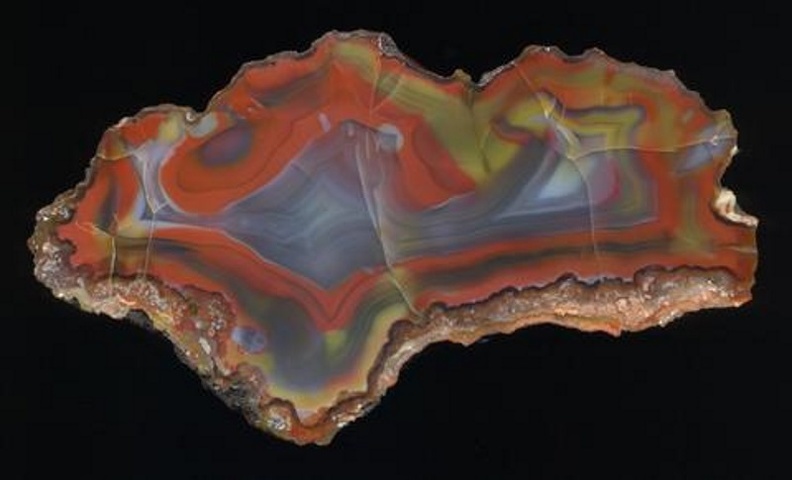


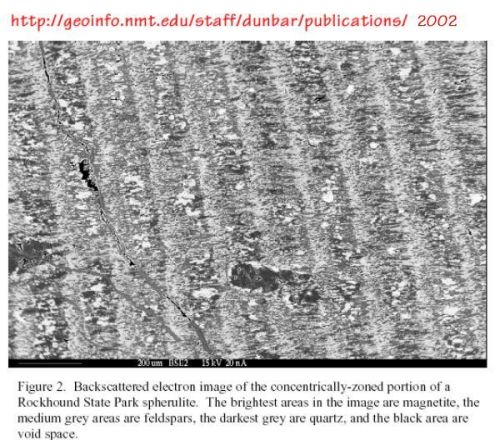
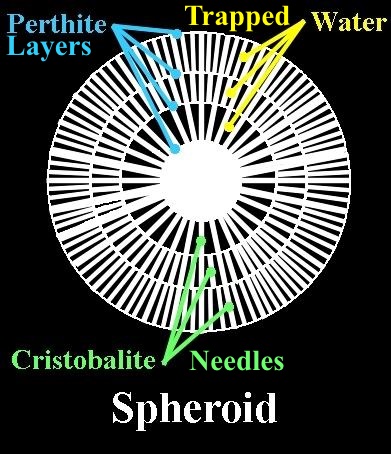
























 Can't wait to show them.. they are fantastic.
Can't wait to show them.. they are fantastic. 





















